We’ve identified a surprising gap in sales performance. We analyzed 340,000 sales conversations in Q1 2021 and discovered top performers generated $47 million in sales, compared to just $19 million by lower performers (~2.5x). So, what exactly made for such a huge gap between top and low sales performance?
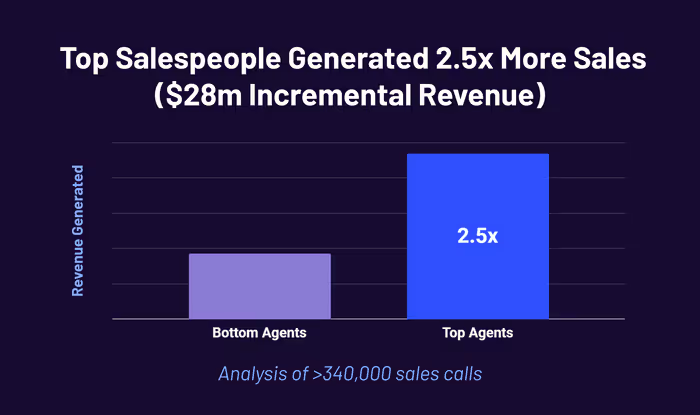
We wondered that exact same thing! And, as it turns out, the behavior of the top performers we studied involved four categories time and time again:
- Setting expectations
- Quality discovery
- Objection handling
- Always assuming the sale
We refer to these at the Magic 4. And while no one of these behaviors is completely new, this is the first time we’ve seen data supporting their consistent potency when enacted together. That’s exciting. So, let’s see how variation in these behaviors contributes to the Sales Performance Gap.
1. Top Sales Performers Set Clear Expectations
Top performers start each call by setting clear expectations. These expectations serve as guide rails, leading prospects and agents along a path toward success. On the other hand, agents who allow prospective customers to dictate the terms of the call find it prohibitively difficult to succeed. And our research bears this out. Top performers:
- Are 40% more consistent in setting expectations than bottom performers
- Set expectations at a higher rate for both new prospects (46% more often) and existing customers (33% more often)
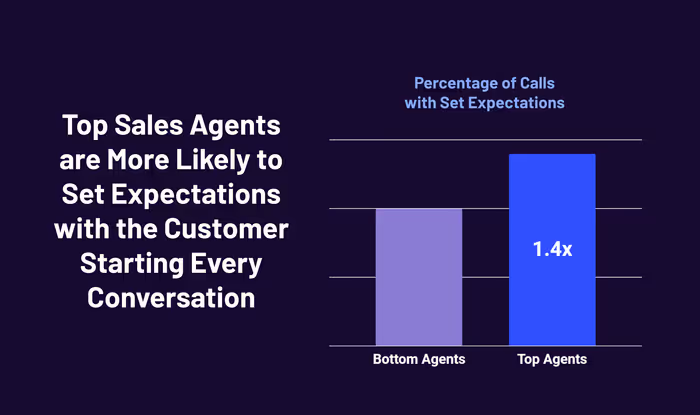
Top performers set expectations by starting their calls with “upfront contracts.” These contracts are the deliberate process of gaining buy-in from the prospect before the sales process begins. The agent ensures their goals are aligned with those of the potential customer and that there is agreement in how the call itself will unfold. Setting the stage in this way benefits the sales process in two main ways:First, humans are intuitive and rely on reference points to understand the world at large. Setting expectations through the upfront contract process establishes reference points, helping the prospect maintain their bearings as they engage with the agent. Second, by opting into upfront contracts, prospective customers are less likely to be put off or annoyed when the call doesn’t go exactly as they thought it would.
2. Top Sales Performers Ask the Right Discovery Questions
No two sales conversations are alike. This is why, even with expectations set, top performers make no assumptions about the prospect or how the call will unfold. Instead, they work to gain a holistic understanding of each prospect through strategically selected ”discovery questions”. And our analysis shows that leveraging a variety of the right kind of questions pays off. Out of the 11 categories, our AI discovered during discovery top performers:
- Asked more questions in 9 of the 11 categories than low performers did
- Asked 48% more discovery questions on average than did their lower-performing counterparts, with the gap increasing to 545% (~6.5x) for certain types of discovery questions
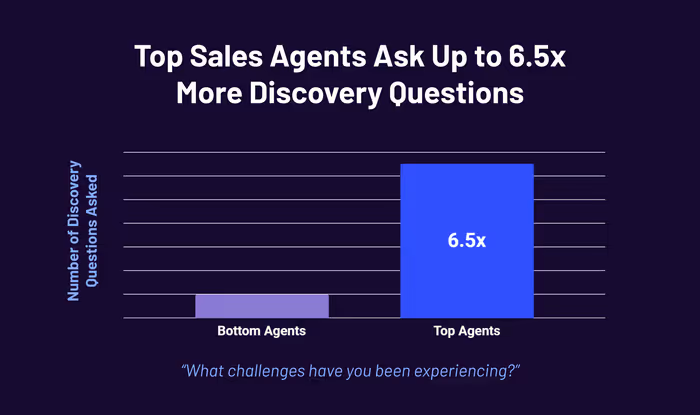
What are the right kinds of questions? The initial line of questioning focuses on categorizing a customer into the right market segment (e.g, demographic information in B2C sales and number of employees in B2SMB sales). Then, top performers typically shift to focus on questions related to needs the primary product or service solves:
- What is your current status quo without our product (or service)?
- What is the hardest thing for you to do in your current status quo?
- What are you looking to accomplish with our product (or service)?
It is normal for all agents to do general categorization discovery on the background of their potential customers. It’s also best practice to collect information related to the needs of the product or service being sold. Our analysis bears this out; top-performing agents asked general categorization and primary product discovery questions 29% more often than bottom performers. That said, top agents additionally leveraged what they’ve learned about the customer’s background and primary product needs to ask relevant discovery questions about potential cross-sell, upsell, and bundling needs. In our sample set, top agents consistently went above and beyond in this way, asking upsell discovery questions a substantive 115%(!) more often than their peers.
3. Top Sales Performers Turn Objections into Opportunities
No matter how good a sales agent gets, prospects will always have objections. More often than not, objections will be related to price (58% of the objections we analyzed were price-related). But, while low performers may simply accept the objections, top performers lean in, working to transform moments of objection into opportunities.
- Top agents we identified were more proficient at handling price objections than their peers by addressing them 64% more often
- They were also 28% more proficient in handling authority objections, such as a prospect wanting to consult someone else in the buy decision (e.g., their manager, spouse, etc.)
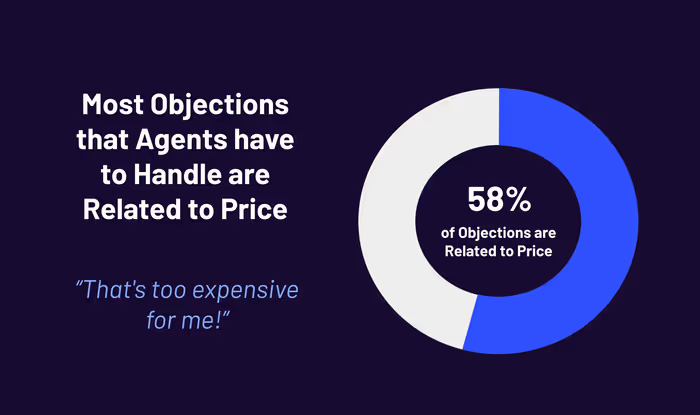
What’s more, our analysis shows that top sales performers put our previous behavior to work here, too – discovery questions can be an excellent means for turning objections into opportunities. Some examples from our analysis include:
- Objections to value - “To make sure I addressed your needs, could you tell me what concerns you have about the recommendation I made?”
- The need to consult authority - “Who will you need to speak with to make this decision? Are they available to chat about the concerns they may have?”
After the discovery questions are asked, do top performers then turn their efforts to closing the deal? Actually, no. In our analysis, top performers are selling before the sale even begins.
4. Top Sales Performers Always Assume the Sale
While low performers hope a sales opportunity will occur, top performers ensure a sales opportunity occurs. By setting the stage, asking discovery questions, and overcoming objections, top performers have built the rapport and trust to safely assume a sale. They overwhelmingly assume a sale 2.3x more often than low performers, and they do so from the very first moment of the call.
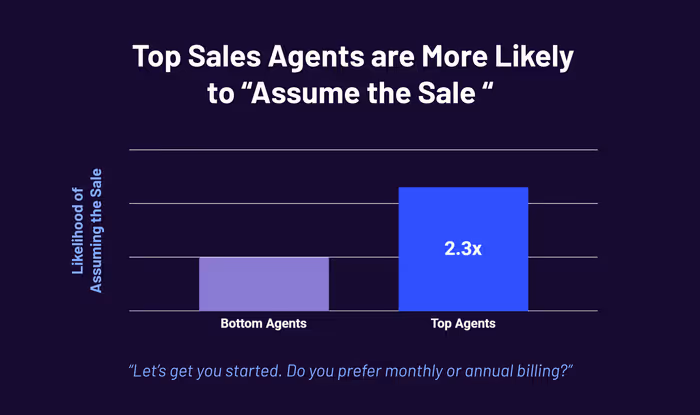
The fourth of the Magic 4 behaviors is also interesting, in that top performers are 40% more likely to assume the sale even when the odds are stacked against them in “hail mary” situations. On top of that, top performers are 22% more likely than low performers to attempt an upsell during sales calls. Are top agents just faking it until they make it, or is there something deeper at work here? To be fair, the fake-it/make it aphorism does have some traction in both psychology and neuroscience. Due to embodied cognition, the state of the body can impact one’s state of emotions. Examples of this include how forcing a smile can actually improve your mood. Slouching posture can amplify how tired or sad one feels. And, apropos to our top performers, self-belief can increase one’s tendency to be correct. In assuming the sale, our top performers most likely come across as more committed and consistent to their prospects. These are two key components in the theory of sales psychology, as outlined in Dr. Robert Cialdini’s book Influence. According to Cialdini, once a potential customer makes a decision, he or she will tend to stick to it. By assuming the sale, top performers are primed to look and ask for small initial commitments, which can be sustained and built upon over the course of the call. Cialdini also notes, assuming a sale in this way helps when agents nudge prospects to take certain standpoints. In doing so, they are gently encouraged to follow the path established by our prior three top behaviors.
How to Change Agent Behavior to Close the Sales Performance Gap
So, we’re seeing ample evidence that the Magic 4 Behaviors can be key in closing sales performance gaps. But, what now? How can you "attack the gap" within your own teams? Start by understanding that enacting lasting change within organizations involves role modeling, fostering understanding and conviction, developing skills and talent, and reinforcement through social mechanisms. And while strong coaching and management are imperative for change enablement, bolstering these efforts through AI-powered real-time coaching intelligence expertise platforms like Cresta provides exceptional advantages. Download our free e-book, Closing the Sales Performance Gap, to learn more about the Magic 4 Behaviors and how Cresta’s helping put them to work to close sales performance gaps.




